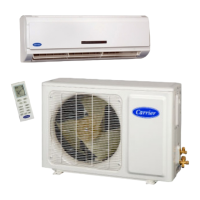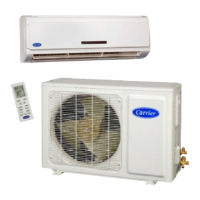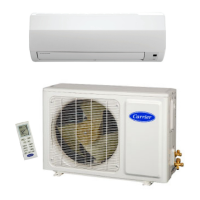8
APPLICATION DATA
UNIT SELECTION
When selecting a variable speed system match the system capacity
range to the anticipated load range.
Since a variable speed system can accommodate a wide range of
loads it is important to understand the percentage of time that the
system will be required to run at the both the maximum and the
minimum load points.
If it is anticipated that the system will be required to run at the
maximum load point for the majority of the time, the next larger
system capacity should be selected.
0%
20%
40%
60%
80%
100%
120%
140%
Outdoor Temperature ˚F (˚C)
55 (12.8)
75 (23.9)
95 (35)
125 (51.7)
Indoor Temp. 80/67_F (26.7/19.4_C) (db/wb) --- Indoor Fan High Speed
D =RatingPoint
A09176
Fig. 6 – 38GXQ009 / 40GXQ009 Cooling
0%
20%
40%
60%
80%
100%
120%
17 / 15
(-8.3 / -9.4)
35 / 33
(1.7 / 0.6)
45 / 43
(7.2 / 6.1)
62 / 57
(16.7 / 13.9)
Outdoor Temperature °F (°C) (DB/WB)
Indoor temperature 75_F (23.4_C) (db) --- Indoor Fan High Speed
D =RatingPoint
A09178
Fig. 7 – 38GXQ009 / 40GXQ009 Heating
0%
20%
40%
60%
80%
100%
120%
140%
Outdoor Temperature ˚F (˚C)
55 (12.8)
75 (23.9)
95 (35)
125 (51.7)
Indoor Temp. 80/67_F (26.7/19.4_C) (db/wb) --- Indoor Fan High Speed
D =RatingPoint
A09177
Fig. 8 – 38GXQ012 / 40GXQ012 Cooling
0%
20%
40%
60%
80%
100%
120%
140%
17 / 15
(-8.3 / -9.4)
35 / 33
(1.7 / 0.6)
45 / 43
(7.2 / 6.1)
62 / 57
(16.7 / 13.9)
Outdoor Temperature °F (°C) (DB/WB)
Indoor temperature 75_F (23.4_C) (db) --- Indoor Fan High Speed
D =RatingPoint
A09179
Fig. 9 – 38GXQ012 / 40GXQ012 Heating
38/40GXQ

